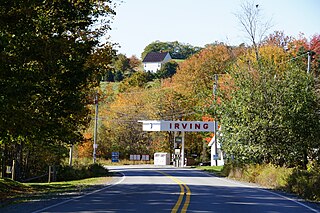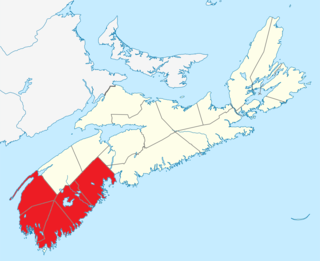Upper LaHave is a community in the Canadian province of Nova Scotia, located in the Lunenburg Municipal District in Lunenburg County on the shore of the LaHave River.
Coordinates: 44°22′4.07″N64°27′7.13″W / 44.3677972°N 64.4519806°W
Upper LaHave is a community in the Canadian province of Nova Scotia, located in the Lunenburg Municipal District in Lunenburg County on the shore of the LaHave River.
Coordinates: 44°22′4.07″N64°27′7.13″W / 44.3677972°N 64.4519806°W
The Lighthouse Route is a scenic roadway in the Canadian province of Nova Scotia. It follows the province's South Shore for 585 km (364 mi) from Halifax to Yarmouth.
Chelsea is a community in the Canadian province of Nova Scotia, located in the Lunenburg Municipal District in Lunenburg County, Nova Scotia. It was probably named for Chelsea, London.

Newcombville is a community in the Canadian province of Nova Scotia, located in the Lunenburg Municipal District in Lunenburg County 11 kilometers or seven miles from Bridgewater-the county service center on the shores of the LaHave River.
Blockhouse is a community in the Canadian province of Nova Scotia, located in the Lunenburg Municipal District in Lunenburg County. It was named after the blockhouses constructed by Captain Ephraim Cook to protect colonists following a raid in 1756. The final blockhouse in the community burned down in 1874.
Conquerall Mills is a community in the Canadian province of Nova Scotia, located in the Lunenburg Municipal District in Lunenburg County near Bridgewater and Conquerall Bank which are located on the shore of LaHave River. Conquerall Mills is dominated by Fancy Lake which is the source for the picturesque Petite Rivière. Fancy Lake is home to small mouth bass and the invasive species of chain pickerel. There are warnings against fishing the endangered Atlantic White fish which are rumoured to exist in the Fancy Lake/Petite Rivière system. The community is 125 kilometers southwest of Halifax.
Walden is a community in the Canadian province of Nova Scotia, located in the Lunenburg Municipal District in Lunenburg County on the shore of the LaHave River.
Upper Chelsea is a community in the Canadian province of Nova Scotia, located in the Lunenburg Municipal District in Lunenburg County.
Dayspring is a community in the Canadian province of Nova Scotia, located on the banks of the Lahave River in the Lunenburg Municipal District in Lunenburg County. It is home to the traditional wooden shipyard, Snyder's Shipyard, builders of Theodore Too, among many other vessels, as well as The Riverview Enhanced Living Centre, Miller's Point Peace Park, the Municipal Activity and Recreation Complex and the Bridgewater/Dayspring Airpark.
West Northfield is a community in the Canadian province of Nova Scotia, located in the Lunenburg Municipal District in Lunenburg County. It lies in a drumlinized area along the LaHave River. The loam-textured podzolic soils tend to be strongly acidic and stony. However, favorable drainage and moisture-holding capacity make them suitable for agriculture and forestry. A Christmas tree industry has developed around the community in recent years.
Upper New Cornwall is a community in the Canadian province of Nova Scotia, located in the Lunenburg Municipal District in Lunenburg County.
Blue Rocks is a community in the Canadian province of Nova Scotia, located in the Lunenburg Municipal District in Lunenburg County. It stands to seaward of Lunenburg, Nova Scotia, somewhat to the east. For many years a fishing village, it was discovered by many artists and photographers beginning in the 1940s. Today the village boasts many artists, and there are also numerous guest houses to be found among the fishermen's dwellings.
Upper Branch is a community in the Canadian province of Nova Scotia, located in the Lunenburg Municipal District in Lunenburg County.
Upper Northfield is a community in the Canadian province of Nova Scotia, located in the Lunenburg Municipal District in Lunenburg County.
Stonehurst is a community in the Canadian province of Nova Scotia, located in the Lunenburg Municipal District in Lunenburg County.
West LaHave is a community in the Canadian province of Nova Scotia, located in the Lunenburg Municipal District in Lunenburg County on the shore of the LaHave River. The community is the home of St. Peter's Anglican Church.

The Raid on Lunenburg occurred during the French and Indian War when Mi'kmaq and Maliseet fighters attacked a British settlement at Lunenburg, Nova Scotia on May 8, 1756. The native militia raided two islands on the northern outskirts of the fortified Township of Lunenburg, Rous Island, and Payzant Island. According to French reports, the Raiding party killed twenty settlers and took five prisoners. This raid was the first of nine the Natives and Acadians would conduct against the peninsula over a three-year period during the war. The Wabanaki Confederacy took John Payzant and Lewis Payzant prisoner, both of whom left written account of their experiences.

Southern Nova Scotia or the South Shore is a region of Nova Scotia, Canada. The area has no formal identity and is variously defined by geographic, county and other political boundaries. Statistics Canada, defines Southern Nova Scotia as an economic region, composed of Lunenburg County, Queens County, Shelburne County, Yarmouth County, and Digby County. According to Statistics Canada, the region had the highest decrease of population in Canada from 2009 to 2010, with a population decrease of 10.2 residents per thousand. The region also has the second-highest median age in Canada at 47.1 years old.

St. John's Anglican Church was the first church established in Lunenburg, Nova Scotia, Canada (1753). It is the second Church of England built in Nova Scotia, and is the second oldest continuous Protestant church in present-day Canada. Early on 1 November 2001, St. John's church suffered significant damage by fire. It was restored and re-dedicated June 12, 2005.
The Hillcrest Cemetery is the oldest protestant cemetery in Lunenburg, Nova Scotia and one of the oldest in Canada. The cemetery is adjacent to the Lunenburg Academy. The oldest marker is dated 1761, eight years after Lunenburg was established. Hillcrest Cemetery contains 5 Commonwealth war graves from World War I and one from World War II.

A township in Nova Scotia, Canada, was an early form of land division and local administration during British colonial settlement in the 18th century. They were created as a means of populating the colony with people loyal to British rule. They were typically rural or wilderness areas of around 100,000 acres (400 km2) that would eventually include several villages or towns. Some townships, but not all, returned a member to the General Assembly of Nova Scotia; others were represented by the members from the county. Townships became obsolete by 1879 by which time towns and counties had become incorporated.